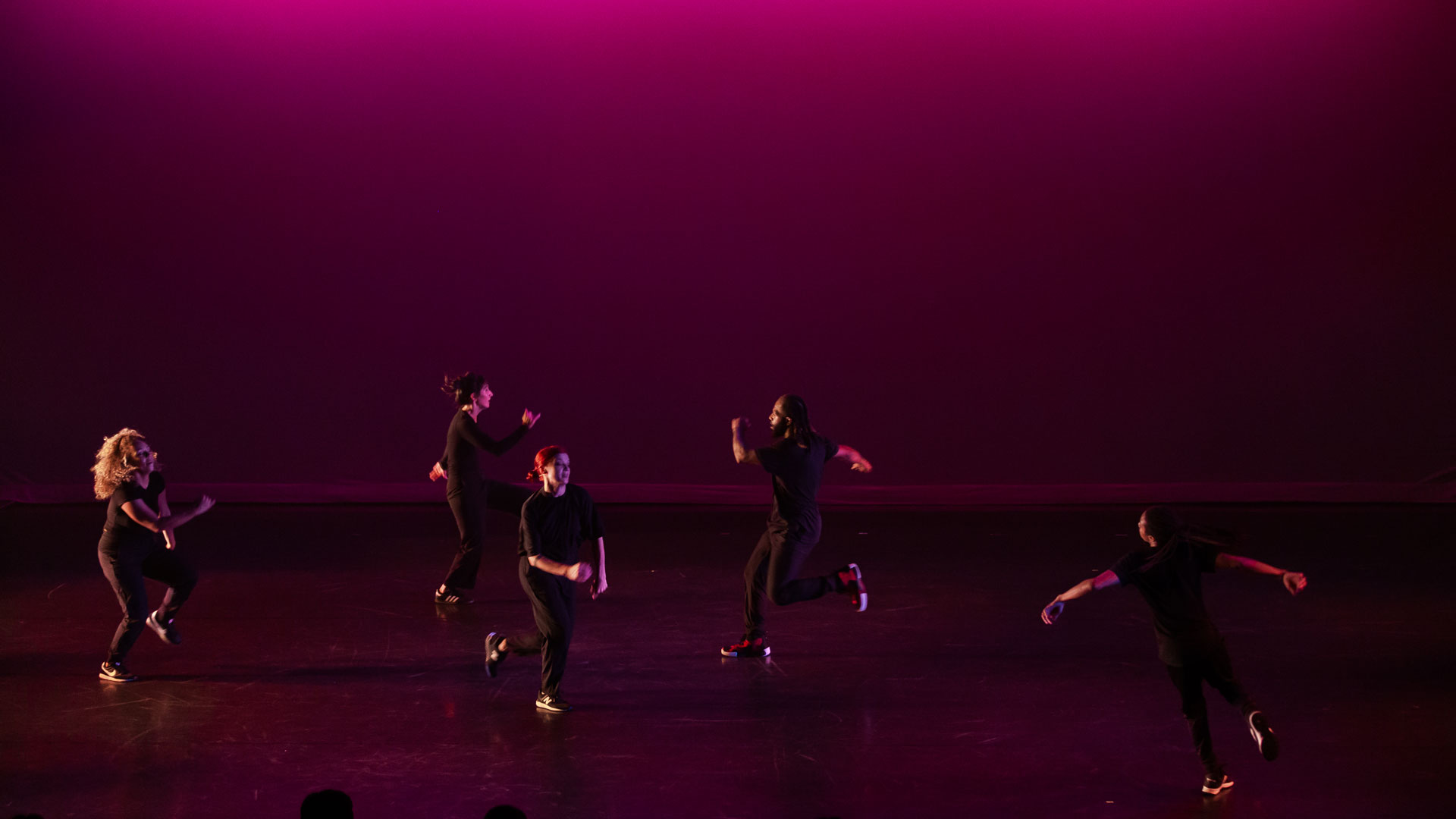
Rennie Harris Pure Movement Is The Next Step documents my personal experience with dance as well as how community dance has evolved into modern Ballet.
inspired by Rennie Harris/Puremovement Nuttin’ But a Word
“There are three laws to hip hop: Individuality, Creativity, and Innovation”
-Rennie Harris
I’m late. I changed in the parking lot into (only slightly) wrinkled dress attire. Park. Run in. My boss waves me forward. “Jacob, yes! I need you tonight! Go in!” I walk through open doors, viewing the back of a raked stage. A friend flags me down, “You’re late.” Through apologies, I notice heavy beats coming through the above speakers. It’s dance music. Classics including: Let Me Clear My Throat, This Is How We Do It, and C.R.E.A.M. Lavender blues blanket the rubber-lined open space.It’s a dance floor where Rennie Harris’ Pure Movement “NUTTIN’ BUT A WORD” is showing in the next few minutes. Going to live performances should be similar to an evening at an art museum.I’ve entered the theater as a clean slate. Going in cold permits a completely fresh experience unhindered by preexisting notions. However, I am an actor. A Chekhov/Laban informed actor, so when I read the pamphlet handed to me, and saw “pure movement” in the title I immediately envision slow, amorphous gestures and British accents. Not here.
A projected face appears in the darkening room. A man with a short beard speaks with authority. His final sentence resonates out --“Movement is the manifestation of your reality. So, keep moving.” A flood light flashes down creating a concise stage. A group gathers. One by one, a dancer steps into the light. A huge man throws himself up and down from a push up position as if he is connected to invisible wires. A woman half his size with pink hair steps in and transforms her body into water. Another man pounces in as she jumps out and begins to rapidly move his weight up through his feet, legs, and hips. It looks similar to Jookin. . . because it is Jookin! It finally clicks that all of their movements are either inspired by or directly pulled from hip-hop. They’ve circumscribed community/street dance into a confined space. It’s like when Banksy started painting on canvases. They’ve placed community dance into the arthouse. It is completely natural. The crew breaks into spontaneous group movement that perfectly syncs to the ticking chime of a clock. This portion, entitled C ontinuum, serves as an exhilarating introduction to the rest of the show and demonstrates Harris’ first law of hip-hop – Individuality. Although the ensemble moves together in similar motions, the choreography cedes ownership to the performing individual . Simultaneously, the group observes itself while still maintaining freedom to break out into duets or solos. The individual shines alongside the majority. This mutability also highlights the ensemble's diversity of skill, talent, and physique . Every dancer has a unique skillset as well as appearance. No one is quite the same height, build, or complexion but all retain the same essence which ties them together. The hour flies by. Ethereal images brand themselves into the audience’s psyche. A short, dark-haired woman fights back offenders as the sun sets, four women call on mother earth to heal their fellow man, two brothers smoke a joint by the Nile River. The younger holds the older as he takes his last breath. And just before the mood becomes too melancholy, brilliant oranges and yellows flash. The group jumps and claps as they form one last dance circle. First and foremost, this production makes y ou ( and those around you) want to dance. And we did. As I’m walking to my car my friend calls back out to me “Ok, see you tomorrow after the thing!” I’m confused. “What? I don’t work till three!” She’s confused. “No Jake! The hip hop masterclass thing! It’s at ten. . . right?”
I’m late. . . again. I try to warm up as best I can. As I survey the room, it’s immediately apparent that I have no business being here. Nashville choreographers and experienced dancers fill the space. I saw the word “masterclass” and immediately enrolled a month ago. I plop myself into the lower right-hand corner of the space and pray. Rodney S. Hill, the RHMP Company Manager steps forward. Over the next hour he walks us through philosophy, history, and of course, choreography. I managed to get by. By the end, I gingerly (shout out to the ginger kid at the front who killed it) stayed with the group and hit the major beats. It is incredibly enlivening. We feel powerful. We kept our knees bent. We moved like we had somewhere to be. At the final count we were spent. We breaked for water and -- hey! The pink haired lady from last night! Over the next hour, Emily Pietruszka (Em) taught us House-based choreography. Notably different from what Rodney coached us through, but still classified as hip-hop, and completely above my skill level. While before I could limp along, here I stood completely outclassed. The photographer for the class tried her best to work around me. The six-foot-four dancer in a pink durag that stood behind me drew me close and whispered “Switch with me baby.” Sweeter words were never spoken. From a distance, I could watch the group more clearly. When we swayed into floorwork I tagged in. Emily stressed the importance of allowing the music to define our movements. Keeping up with the group was secondary, internalizing the movements and understanding the cultural story they had to tell us remained paramount. At the end the group performed for each other. Each person could only perform the choreography as themselves. Slowly, the group started to influence itself and by the last dance Harris’s second law, ripened in full manifestation. Creativity is the breadth of dance. It’s the indivisible energy that keeps movement a live. Subconsciously, I had categorized hip-hop as a kind of. . . party dance? It was something only cool kids could do. I see someone do a sick move and think of it as a party trick. Like a backflip. But within the studio, I had the opportunity to feel the dance in my own body. I felt an influence infinitely more substantial – technique. Hip-hop is no different than Ballroom, Swing, or Ballet. It possesses its own independent progression with accompanying beliefs, laws, and schools of thought. It is a complete form. Not a gimmick. I had to see more. I called a friend.
I’m there 45 minutes early. This time I’m at the very front. I want to be able to properly see every detail. Lights up, and I see Emily rewriting our story from class with a slightly different twist. Her transformation from teacher to an immersed, flowing creature is breathtaking. This humanization spread through to the other cast members. While the night before, the energetic and emotional veracity amplified by the movements struck me -- here the hundreds upon hundreds of hours each individual dancer had accumulated bubbled up from the group. These were craftspersons as well as magicians. The historical origins of each movement surfaced from moment to moment. One motion felt more from Philadelphia, another from Memphis. Salsa intermingled with Hoodlocking. Each segment of the performance synthesizes further innovations t o pure dance. A quote by Wolfgang Paalen, breezed into my mind. Originally, modern paintings realistically depicted an idea such as a person, a place, or scene. The picture would proclaim to itself and to the viewers -- “This is what I represent.” In the 1940’s art mutated along with the political and economic systems of the world. “Paintings no longer represent. Today it has become the role of the painting to look at the spectator and to ask him: ‘what do you represent?’”-- Form and Sense, 1945. The same phenomenon has repeated in dance Classical Ballet and its respective contemporaries create strong images that pierce the viewers’ intellect, and from there (like a beautiful painting) informs our emotionality. Ballet is self proclaimed. However, here, the reverse has become equally true. Through dance, Rennie Harris Puremovement now directly pierces our emotional body to directly ask our collective intellect while recognizing our individualities. . . What do you represent? This, in action, effectively encapsulates Harris’ third and final law of hip hop-- innovation. There is no doubt that in the world of dance/movement Rennie Harris Pure Movement is the next step.


